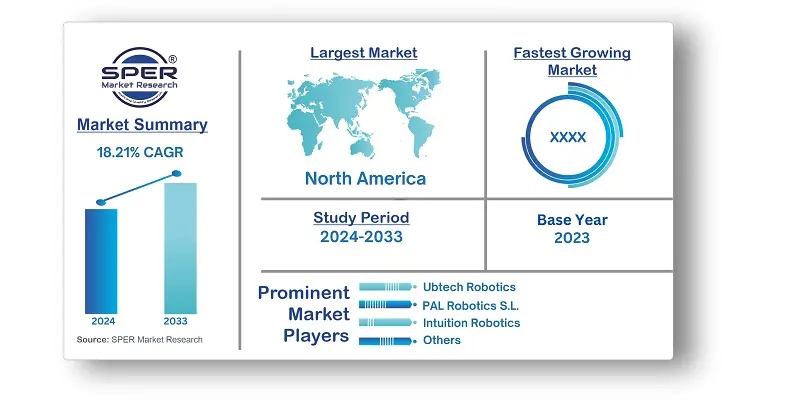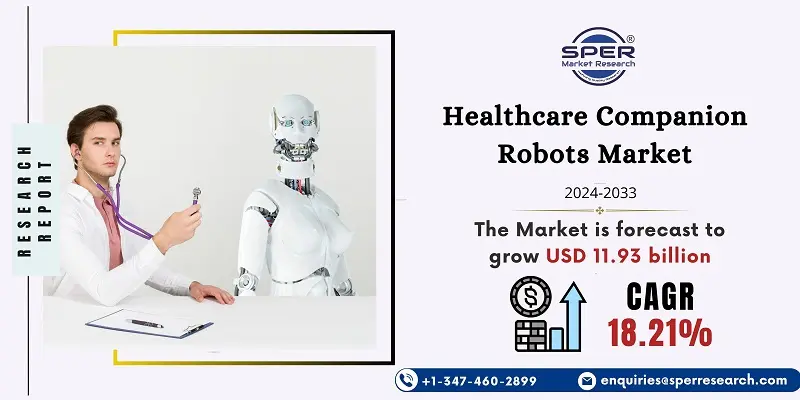
Healthcare Companion Robots Market Trends, Share, Demand, Revenue, Size and Future Outlook
Healthcare Companion Robots Market Growth, Size, Trends Analysis- By Robot Type, By Age Group, By End User- Regional Outlook, Competitive Strategies and Segment Forecast to 2033
| Published: Oct-2024 | Report ID: HLCA2484 | Pages: 1 - 248 | Formats*: |
| Category : Healthcare | |||
- Aeolus Robotics debuted aeo, a dual-arm humanoid robot, in January 2023. It offers new uses for a range of service functions, including as delivery, security, eldercare, kiosk operation, and cleaning using ultraviolet light. By addressing a variety of needs across many sectors and expanding its application possibilities, this creative launch improves the company's competitiveness in the market.
- ElliQ, Intuition Robotics' digital care companion, had its official debut in March 2022. ElliQ is a proactive partner for older individuals, encouraging them to preserve their independence and adopt a healthy lifestyle. Its design supports ageing in a healthier and happier way. The company's client base was greatly increased by this launch, which also improved its standing in the marketplace.


| Report Metric | Details |
| Market size available for years | 2020-2033 |
| Base year considered | 2023 |
| Forecast period | 2024-2033 |
| Segments covered | By Robot Type, By Age Group, By End-Use. |
| Regions covered | North America, Asia-Pacific, Latin America, Middle East & Africa and Europe. |
| Companies Covered | Aeolus Robotics, Inc, Andromeda, ASUSTeK Computer Inc, Blue Frog Robotics & Buddy ASUS, inGen Dynamics, Intuition Robotics, Luvozo, PAL Robotics S.L, PARO Robots U.S., Inc, Ubtech. |
- Healthcare Robotics Manufacturers
- Hospitals and Healthcare Facilities
- Elderly Care Centers and Nursing Homes
- Rehabilitation Centers
- Home Healthcare Providers
- Patients and Families (Elderly and Disabled Individuals)
- Healthcare Professionals (Doctors, Nurses, Caregivers)
- Technology and AI Developers
- Medical Device Distributors
- Government and Regulatory Bodies
| By Robot Type: | |
| By Age-Group: | |
| By End-Use: |
- Global Healthcare Companion Robots Market Size (FY’2024-FY’2033)
- Overview of Global Healthcare Companion Robots Market
- Segmentation of Global Healthcare Companion Robots Market By Robot Type (Animal-Like, Humanoid)
- Segmentation of Global Healthcare Companion Robots Market By Age Group (Children, Adult, Geriatric)
- Segmentation of Global Healthcare Companion Robots Market By End-Use (Nursing Homes And Elderly Care Centers, Hospitals and Clinics, Home Healthcare)
- Statistical Snap of Global Healthcare Companion Robots Market
- Expansion Analysis of Global Healthcare Companion Robots Market
- Problems and Obstacles in Global Healthcare Companion Robots Market
- Competitive Landscape in the Global Healthcare Companion Robots Market
- Impact of COVID-19 and Demonetization on Global Healthcare Companion Robots Market
- Details on Current Investment in Global Healthcare Companion Robots Market
- Competitive Analysis of Global Healthcare Companion Robots Market
- Prominent Players in the Global Healthcare Companion Robots Market
- SWOT Analysis of Global Healthcare Companion Robots Market
- Global Healthcare Companion Robots Market Future Outlook and Projections (FY’2024-FY’2033)
- Recommendations from Analyst
1.1. Scope of the report1.2. Market segment analysis
2.1. Research data source
2.1.1. Secondary Data2.1.2. Primary Data2.1.3. SPERs internal database2.1.4. Premium insight from KOLs
2.2. Market size estimation
2.2.1. Top-down and Bottom-up approach
2.3. Data triangulation
4.1. Driver, Restraint, Opportunity and Challenges analysis
4.1.1. Drivers4.1.2. Restraints4.1.3. Opportunities4.1.4. Challenges
4.2. COVID-19 Impacts of the Global Healthcare Companion Robots Market.
5.1. SWOT Analysis
5.1.1. Strengths5.1.2. Weaknesses5.1.3. Opportunities5.1.4. Threats
5.2. PESTEL Analysis
5.2.1. Political Landscape5.2.2. Economic Landscape5.2.3. Social Landscape5.2.4. Technological Landscape5.2.5. Environmental Landscape5.2.6. Legal Landscape
5.3. PORTERs Five Forces
5.3.1. Bargaining power of suppliers5.3.2. Bargaining power of buyers5.3.3. Threat of Substitute5.3.4. Threat of new entrant5.3.5. Competitive rivalry
5.4. Heat Map Analysis
6.1. Global Healthcare Companion Robots Market Manufacturing Base Distribution, Sales Area, Product Type6.2. Mergers & Acquisitions, Partnerships, Product Launch, and Collaboration in Global Healthcare Companion Robots Market
7.1. Global Healthcare Companion Robots Market Size, Share and Forecast, By Robot Type, 2020-20267.2. Global Healthcare Companion Robots Market Size, Share and Forecast, By Robot Type, 2027-20337.3. Animal-like7.4. Humanoid
8.1. Global Healthcare Companion Robots Market Size, Share and Forecast, By Age-Group, 2020-20268.2. Global Healthcare Companion Robots Market Size, Share and Forecast, By Age-Group, 2027-20338.3. Children8.4. Adult8.5. Geriatric
9.1. Global Healthcare Companion Robots Market Size, Share and Forecast, By End-Use, 2020-20269.2. Global Healthcare Companion Robots Market Size, Share and Forecast, By End-Use, 2027-20339.3. Nursing homes and elderly care centers9.4. Hospitals and clinics9.5. Home healthcare9.6. Other end-users
10.1. Global Healthcare Companion Robots Market Size and Market Share
11.1. Global Healthcare Companion Robots Market Size and Market Share By Region (2020-2026)11.2. Global Healthcare Companion Robots Market Size and Market Share By Region (2027-2033)11.3. Asia-Pacific
11.3.1. Australia11.3.2. China11.3.3. India11.3.4. Japan11.3.5. South Korea11.3.6. Rest of Asia-Pacific
11.4. Europe
11.4.1. France11.4.2. Germany11.4.3. Italy11.4.4. Spain11.4.5. United Kingdom11.4.6. Rest of Europe
11.5. Middle East and Africa
11.5.1. Kingdom of Saudi Arabia11.5.2. United Arab Emirates11.5.3. Qatar11.5.4. South Africa11.5.5. Egypt11.5.6. Morocco11.5.7. Nigeria11.5.8. Rest of Middle-East and Africa
11.6. North America
11.6.1. Canada11.6.2. Mexico11.6.3. United States
11.7. Latin America
11.7.1. Argentina11.7.2. Brazil11.7.3. Rest of Latin America
12.1. Aeolus Robotics, Inc
12.1.1. Company details12.1.2. Financial outlook12.1.3. Product summary12.1.4. Recent developments
12.2. Andromeda
12.2.1. Company details12.2.2. Financial outlook12.2.3. Product summary12.2.4. Recent developments
12.3. ASUSTeK Computer Inc
12.3.1. Company details12.3.2. Financial outlook12.3.3. Product summary12.3.4. Recent developments
12.4. Blue Frog Robotics & Buddy ASUS
12.4.1. Company details12.4.2. Financial outlook12.4.3. Product summary12.4.4. Recent developments
12.5. inGen Dynamics
12.5.1. Company details12.5.2. Financial outlook12.5.3. Product summary12.5.4. Recent developments
12.6. Intuition Robotics
12.6.1. Company details12.6.2. Financial outlook12.6.3. Product summary12.6.4. Recent developments
12.7. Luvozo
12.7.1. Company details12.7.2. Financial outlook12.7.3. Product summary12.7.4. Recent developments
12.8. PAL Robotics S.L
12.8.1. Company details12.8.2. Financial outlook12.8.3. Product summary12.8.4. Recent developments
12.9. PARO Robots U.S., Inc
12.9.1. Company details12.9.2. Financial outlook12.9.3. Product summary12.9.4. Recent developments
12.10. Ubtech
12.10.1. Company details12.10.2. Financial outlook12.10.3. Product summary12.10.4. Recent developments
12.11. Others
SPER Market Research’s methodology uses great emphasis on primary research to ensure that the market intelligence insights are up to date, reliable and accurate. Primary interviews are done with players involved in each phase of a supply chain to analyze the market forecasting. The secondary research method is used to help you fully understand how the future markets and the spending patterns look likes.
The report is based on in-depth qualitative and quantitative analysis of the Product Market. The quantitative analysis involves the application of various projection and sampling techniques. The qualitative analysis involves primary interviews, surveys, and vendor briefings. The data gathered as a result of these processes are validated through experts opinion. Our research methodology entails an ideal mixture of primary and secondary initiatives.



Frequently Asked Questions About This Report
PLACE AN ORDER
Year End Discount
Sample Report
Pre-Purchase Inquiry
NEED CUSTOMIZATION?
Request CustomizationCALL OR EMAIL US
100% Secure Payment






Related Reports
Our Global Clients
Our data-driven insights have influenced the strategy of 200+ reputed companies across the globe.




















